It’s that time of year, when we all become obsessed with bettering ourselves. Rather than a health-focused resolution this year, one of mine involved getting a handle on organizing my garage full of outdoor gear and simplifying the process of packing for trips.
Before diving into what I did, let me give you a little background. I’ve always been a generalist when it comes to outdoor pursuits and dabble in a lot of different sports and hobbies. From bowhunting to mountain biking and backcountry skiing, they’re all pretty gear-intensive, which means I’ve got a lot of equipment.
Watch: Bryan’s First Attempt at Gear Organization
Since I test gear for work, too, all that stuff tends to accumulate rather quickly, outpacing my attempts to keep things organized and leaving me with piles of stuff on shelves and in corners of my garage. I’ve even documented some of my attempts at gear organization in the past, at one point creating a full pegboard wall to house gear.
Ultimately, none of the previous storage systems worked great for us and we wanted a more practical way to stay organized and simplify our lives. When my wife, Sarah, and I freed up some space in our barn last fall, we ended up with an empty room large enough to house our outdoor gear and decided to a new system.
Practical vs. Pinterest Gear Storage
I often get bogged down by wanting my gear room or garage to –like a climbing rack beautifully displayed on a pegboard, backpacks hanging on a wall, and each hobby having its own, well-organized corner of a space that looks more like an REI display than an actual human being’s home.
What I’ve found over the years is that this method works great if you have one main hobby. But, if you’re like me and have a lot of different hobbies where the gear crosses over (think sleeping bags you use for every activity, or walkie talkies you use while backcountry skiing and hunting), it can actually make packing for trips more complicated.
Sarah’s idea was to not only get some new bins and organizational tools, but to change the way we were organizing gear. Rather than grouping things like backpacks, electronics, layers, hunting optics, camp stoves, and cutlery separately, she came up with an “A-team and B-team” bin approach to each sport.

For instance, rather than having a bin labeled “skiing” that’s chock-full of both of our layers, googles, helmets and everything associated with the sport, we now have bins labeled “Bryan Ski,” “Sarah Ski,” and “Backup Skiing.” Everything I always end up taking with me for a day of skiing, including my helmet, goggles, and outerwear, lives in one bin, and any extra items we keep on hand for when friends and family visit lives in the backup bin. This means that instead of rifling through an overstuffed bin full of every pair of gloves and goggles we own just to pack them into another bag every time we want to go skiing, we can just grab our “A-team” bins and toss them in the truck.
That last point is one worth reiterating: keeping our bins stocked with exactly what we need simplifies the packing process immensely. Recently, for instance, we headed to Taos Ski Valley after work for a weekend of skiing. We tossed our skis, boots, and two bins in the van and were out the door in minutes—a process that has taken us significantly longer in the past.
Dos and Don’ts for Gear Storage
- Don’t waste your time making things look beautiful and laying out gear on a pegboard wall. Your garage isn’t an REI.
- Think hard before investing time in building your own “bin rack” or other DIY setup that will take too much time.
- Keep gear organized by sport but also deploy the A- and B-team system. Put the stuff you almost always use in the A-team bin and the backup/extra things in the B-team bin.
- Pony up for nice bins.
- Don’t use see-thru bins.
- Don’t hang packs on a wall—it takes up too much space.
- Keep your bike(s) where you can access them easily.
- Pair down, but don’t Marie Kondo yourself into tossing things you’ll miss one day, even if you rarely use it.
- Use whatever space you have wisely.
The Tools We Used
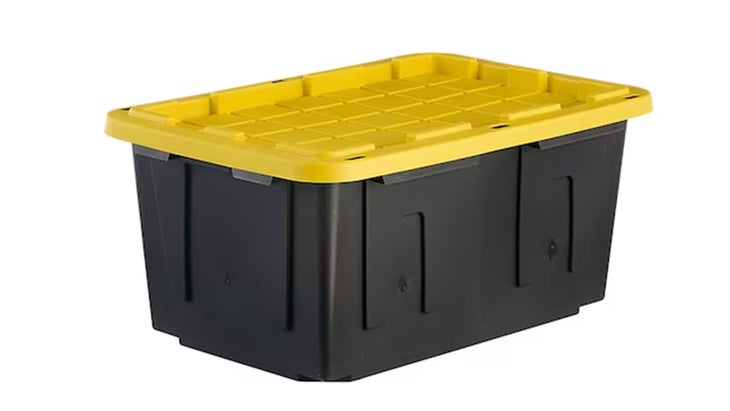
The Project Source Commander 27 Gallon Tote
In the past I’ve used whatever bins, milk crates, and shelves I’ve had on hand to organize my gear. That meant a hodgepodge of cheap, clear plastic bins that often broke or were missing lids, so this time around we invested in a new set of high-quality bins that will hopefully last.
We bought 20 of these (they’re pretty much identical to the you can find at Home Depot), which get great reviews and are, in my opinion, the perfect size. They seem tough enough to toss in the back of a truck without worry, are stackable, have very secure lids, and are large enough to house things like backpacks without getting overstuffed.
I also wanted bins that were not see through for aesthetic reasons—it’s just looks less cluttered than bins that show their contents (plus, we know what’s in each bin and don’t need to see inside).
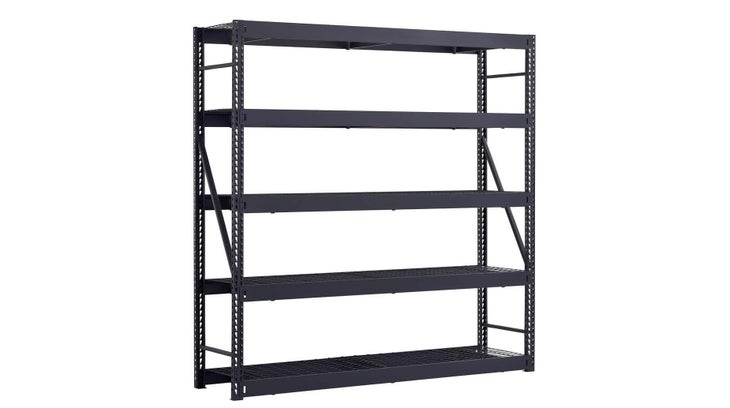
5-Tier Industrial Duty Steel Freestanding Garage Storage Shelving Unit
We toyed with the idea of building a like the ones that have been all the rage on TikTok and Pinterest in the last few years but ultimately went with this from Home Depot. Each shelf supports 1,800 pounds and fits four of the 27-gallon bins perfectly. It was about $100 more expensive than the materials needed to build our own, but I guarantee it’s sturdier, and it took only 15 minutes to put together versus the several hours of time it would’ve taken us to build one.
It might not be as Pinterest-worthy, but it’s a hell of a lot more practical—the way those bin racks are built means you can only pull the bin straight in and out to access its contents, which can make things challenging in tight spaces. But these shelves are a little wider, which makes it easier to maneuver the bins on them. We also re-used a smaller, wire-rack shelf we already had for bulky items—like our coolers, camp chairs, and archery targets—that wouldn’t fit in the bins.
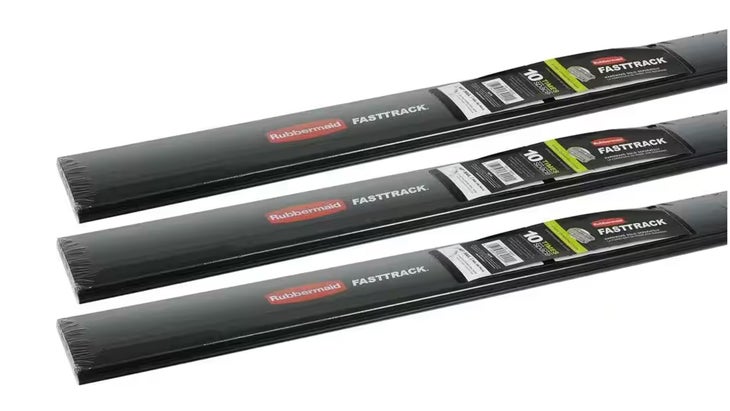
Rubbermaid FastTrack Garage Hang Rails
To store bikes, skis and add a bit more shelving off the ground, we installed by TK. We’ve used this system before, and are big fans of its versatility and sturdiness. I installed a few rails along one wall of the room and hung our bikes using the . I’m a fan of those hooks in particular because they’re rated for 50lbs, which is higher than other brands like Kobalt or Craftsman you can find at the hardware store and means you can hang e-bikes from them if you want. I also installed a couple of metal shelves for fly rods, and a that sits high off the ground for ski boots and sleeping bags. (We had issues with mice nesting in our boots when we kept them on the ground in the past.)
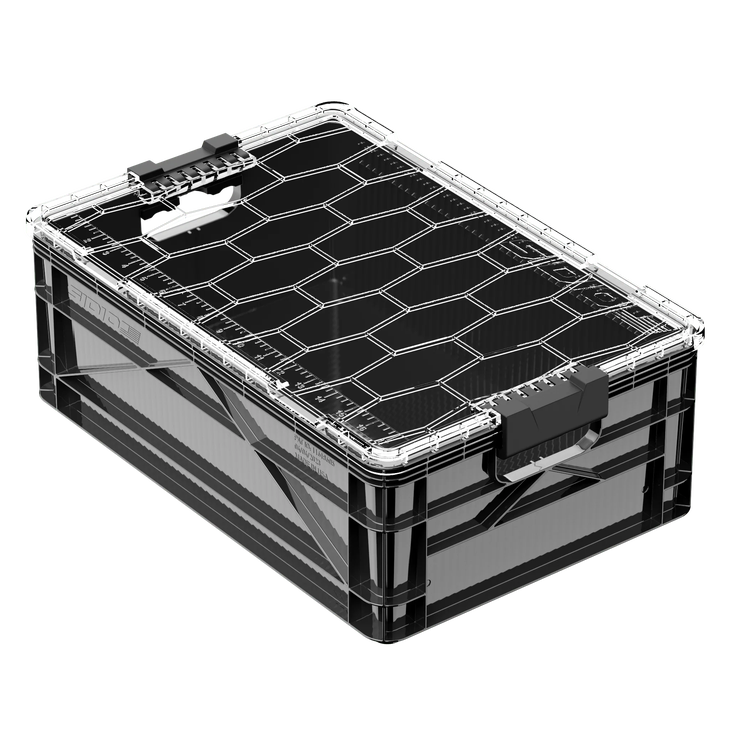
Half Size Sidio Crate
In addition to the big, 27-gallon totes, I also used three Sidio Crates to house small items that didn’t fit into the A/B system. I have one for “gear repair” items, one for headlamps and walkie talkies, and one for various chargers and cables.
How It’s Working So Far
I’m sure we’ll make some tweaks to this whole setup the longer we use it, but so far, we’re in love. Our new bin system is keeping us vastly more organized than before, and it has also dramatically simplified packing for trips.
The unintended benefit of all this is that it freed up a lot of room in our garage, and made it a much nicer space, too. I used to keep everything—from outdoor gear to homebrewing equipment to automotive tools to yard cleaning tools—in the garage, utilizing every inch of available space. That created an area that was often pretty overwhelming to even stand in, let alone try to find the gear I was looking for.
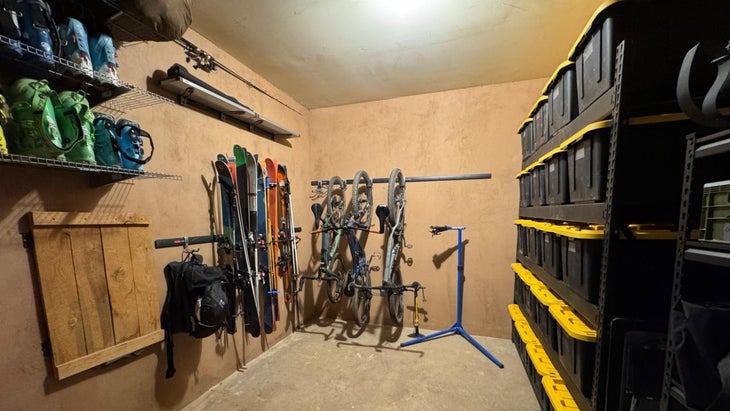
By dedicating a space specifically to our outdoor gear, we can now even park a car in the garage—you know, what a garage is actually for. You don’t need a big house with tons of rooms or, in my case, a barn to make this idea work. My friend turned a spare closet into his gear room, and a simple backyard shed can also work great for this.
The biggest takeaway: If you’ve got a lot of equipment and your life revolves around getting outside, create a dedicated space for it, and consider mixing up how you organize all your gear.


